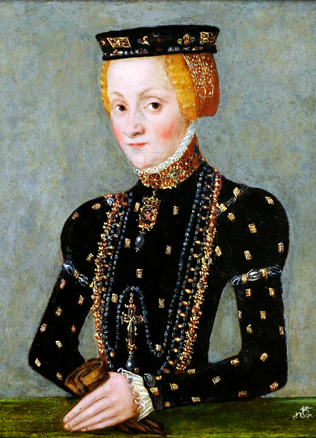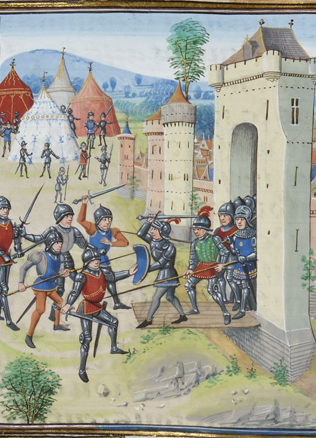The house of the rulers: from the Gediminids to the Jegiellonians
When describing the events in the family of Polish King Jogaila (Jagiełło) Jan Dlugosz noted in the tone of a know-all chronicler that Jogaila, together with Grand Duke of Lithuania Vytautas, sought to achieve that the Kingdom of Poland should be inherited “in the Lithuanian nation and their Gediminas’ family” (in nacione Lithuanica et in familia et in domo sua Gedimina). The words of this famous Polish historian of the second half of the 15th century and the educator of the children of King Casimir Jagiellonian, on the one hand, demonstrate his constant and unfading distrust in the first King of Poland from the Lithuanian house, however, at the same time it reflects historic memory of the Lithuanian dynasty reigning in the Crown of Poland and the Grand Duchy of Lithuania. “Gediminas’ family” – this is how the Rulers of Poland and Lithuania perceived and called themselves at the end of the 14th and at the beginning of the 15th centuries.
The natural right to rule
Since hardly any sources of the 13th century have survived, it is difficult to say something about the origin of this house and about the earliest history of Lithuania. There are no reliable data, which could help us elucidate the family relations of the Gediminids with the families of the earlier Rulers of Lithuania Mindaugas and Traidenis. The first representatives of the Gediminids family became known at the end of the 13th century during the political upheaval, which started after killing the first and the only King of Lithuania Mindaugas. The main patrimonial domains of the Gediminids, like those of other important noble families, stretched in the so-called “real Lithuania” (Lithuania propria) – in those lands of the present-day Lithuania and West Belarus, which were the political kernel of the country from the time of the creation of the State of Lithuania.
“
The first representatives of the Gediminids family became known at the end of the 13th century during the political upheaval, which started after killing the first and the only King of Lithuania Mindaugas.
Main centres were Vilnius and Trakai from which the dukedoms of Vilnius and Trakai formed in the long run. The ancestors of the Gediminids, beginning with the first known Duke Putavyras (Pukuveras) Butvydas (1292–1294) and under the rule of his sons Vytenis (1295–1316) and Gediminas (1316–1341), within several decades managed to establish dynastic rule all over the state. In the 15th century the chroniclers called this dynasty retrospectively by the name of Gediminas because the memory of the family went back as far as this person who ruled in the first half of the 14th century only. The history of Lithuania and the ruling family in the earliest work on the history of Lithuania (Chronicles of the Grand Dukes of Lithuania) created at the beginning of the 15th century in the milieu of Grand Duke of Lithuania Vytautas began with Gediminas, the grandfather of Jogaila and Vytautas. The dynastic tradition regarded him as the progenitor of the family and the founder of Vilnius, the capital of the country. The erudite historians of the 19th-20th centuries found his forgotten progenitors in the chronicles of foreign countries. On the other hand, the epoch of Gediminas really marked a new political period. At that time the idea of the “ruling family” (stirps regia) appeared, which assured the right to rule the country to the persons who were from the ruling dynasty by birth. From that time only direct descendents of Gediminas could become grand dukes who considered themselves and were recognised by others to be natural rulers (domini naturales), and the state was referred to as the Ruler’s patrimony.
Gediminas’ international policy of marriages also served the establishment of the conception of the ruling family, when many sons and daughters of the ruler were married off to the representatives of the dynasties of the neighbouring countries. Owing to the policy of marriage the first peaceful contacts with Christian Poland were established. Especially close relations formed with neighbouring Masovia where the Lithuanian princesses after settling there intermediated for their pagan relatives who experienced political isolation and helped them find diplomatic roads to the West. Meantime Gediminas looked for the inheritors of the lands in eastern Russian lands successfully applying the marriage strategy widespread in Europe at that time annexing territories through dynastic marriages.
From the relatives to the family
The Gediminids ducal family was large in the 14th century, Algirdas alone had twelve sons. Seeking to reduce a threat of conflicts over the throne, the future heir was determined in advance and conditions favourable to take over power were created for him. In this way every time a new dynastic branch appeared in the ruling family. The name of the Gediminids already existed at that time; however, the patronymic names that were used reflected real self-awareness of the ducal family: Algirdaitis (this is how Grand Duke Švitrigaila called himself in 1413), Kęstutaitis, Kaributaitis, etc. The Gediminds house should be imagined as a group of individuals linked by the ties of unequal closeness, which not always acted as a joint political unit. A fatal turning-point took place when the dynasty was begun to be understood as a sequence of the rulers of one family replacing one another according to the principle of genealogy rather than by a circle of relatives of a single generation.
“
Later only the sons born in the family of the ruler were considered to be the only lawful inheritors of the Grand Duchy of Lithuania.
The Gediminids experienced these significant changes in the 15th century. Jogaila and Vytautas managed to introduce the principle that there cannot be any formations of ducal power in the country restricting the power of the sovereign. In the times of Vytautas the process of destroying or dividing individual dukedoms started, which was continued by his descendents on the throne of the Grand Duke. The result of this process was the changed status of the last and traditionally strongest dukedom of Kiev in 1470 and an administrative unit founded instead of it – the Palatinate of Kiev. Such a development affected the world outlook of the Dukes who came from the Gediminids family. Like other noblemen they started to call themselves by the inherited names, which were formed according to the name of the first representative of the new branch (Olelkaičiai, Sanguškos) or were constructed from the name of the major domain (Bielskiai, Čartoriskiai, Zaslavskiai). A part of them continued to entertain the idea of independent reign and ruled though small but consolidated territories. Still, they began more and more to resemble other influential magnates who had no sovereign rights. Though some of them perhaps thought otherwise, they could not become grand dukes. It was only the preserved title of a duke that reminded of the old power of their fathers. Later only the sons born in the family of the ruler were considered to be the only lawful inheritors of the Grand Duchy of Lithuania.
The descendents of King of Poland and Grand Duke of Lithuania Jogaila – Jogailaičiai (Jagiellonians) became this kind of house in the 15th century. When, after the death of Vytautas’ brother Žygimantas (1432–1440) and his son Mykolas, the Kęstutaičiai branch ended, and as Jogaila’s brother Švitrigaila (1430–1432) left no offspring, Jogaila’s sons and grandsons could launch power of the new branch of the Jogailaičiai dynasty. The rule of Jogaila’s younger son Casimir Jagiellonian that lasted for as long as 52 years was fatal. During this period the relations between Poland and Lithuania were coordinated and the personal/dynastic union based on the political system became established. The inherited dynastic name of Jogailaičiai that was related to the name of Jogaila rather than to the name of Gediminas, which appeared at the turn of the 15th – the 16th centuries, testifies to the changes that took place in dynastic self-awareness in the 15th century. This shows clearly the superiority of the royal power and the changed perception of the Ruler’s family. Though the roots of the Gediminids dynasty were not forgotten, from that time the persons born in the royal family were called “de Jagellonum familia”.
Rimvydas Petrauskas



